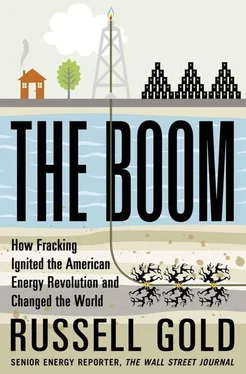Living near a well under construction isn’t easy. Traffic, noise, and foul air are constant and legitimate complaints. A Chesapeake vice president, in a candid speech, said in March 2012 that while people like natural gas, “making it can be problematic. Nobody likes that part. I can tell you this: the sausage making will get better and better and better.”
The Burkburnett boom—and dozens like it—paved the way for the American century and its unmatched prosperity. Will the shale boom, occurring in a new century with modern environmental sensibilities and concerns, resemble the old booms? Or is there a new path available to the United States, one that emerges from the new proximity of hundreds of thousands of shale wells and millions of Americans? Will the industry create a new generation of Ottis Grimeses—or will it create more Emily Krafjacks?
One thing is for certain. Simply to keep oil and gas production in the United States flat, the industry must drill thousands of wells every year, often packed closely together. This is due to the stingy nature of the rock.
———
Shale is dark and dense, surprisingly heavy in the hand. Scott Tinker reached into a three-foot-by-three-foot cardboard box and pulled out a cylinder of shale cleaved in two pieces. “Here’s good, dark shale,” he said. “The organics make it dark when they rot.” A blackboard hue indicated that organisms once lived and died there, turning into fossil fuel. We were standing in a warehouse on the north side of Austin, Texas, piled from the floor to the thirty-foot ceiling with racks of these boxes. It reminded me of the final scene from Raiders of the Lost Ark. Tinker called his collection the Library of Congress of rocks.
Tinker, the head of the University of Texas Bureau of Economic Geology, one of the world’s foremost institutes for studying petroleum rocks, held the shale near his face and licked the flat side of half a cylinder. His tongue cleaned the dusty surface. “Now you are looking at the rock texture,” he said, holding it out for me to examine. It appeared uniform, with no visible striations, and solid. To see the tiny holes where the oil and gas is trapped requires a $2 million scanning electron microscope. Breaking into these vaults demands a lot of muscle.
The first step is to drill a long well straight down, which is then typically turned so that the hole, known as a wellbore, runs parallel to the surface, traveling through the horizontal layer of shale. A conventional sandstone reservoir, with large interconnected pores full of fossil fuel, is like an inflated balloon. When the balloon is punctured, air rushes out. Similarly, when the drill bit churns its way into a reservoir, the oil and gas stampede into the well. But shale is so solid that next to nothing enters the well unless it is “stimulated.” A company pumps in liquid—mostly water, mixed with sand and a cocktail of chemicals to reduce friction, thicken the water, and kill any hitchhiking bacteria carried from the surface—under extraordinary pressure. Water doesn’t compress, so when forced up against a rock at rising pressure, it will cause the rock to break.
When it breaks, the frack fluid rushes out of the well and into the newly opened space. The fluid often carries sand, which will remain behind to prop open the new fractures and prevent them from closing up again when the liquid is retrieved. More water, more pressure, more fractures. A driller might execute dozens of fracks along the horizontal leg of a well, transforming an impermeable block into rock riddled with tiny cracks. Each crack exposes the shale to what amounts to a tiny brook that leads to a small stream and so forth until it reaches a river (the well itself) that connects the shale to the surface. A petroleum engineer who calculated how large an amount of shale was exposed by a typical frack estimated it was one hundred million square feet—or the floor-space equivalent of about thirty-five giant malls.
A lot of natural gas, or oil, will rush into the new fractures. A newly fracked well produces much of its energy in its first few months. But the story doesn’t end here. There’s an enormous pressure difference between the shale and the fractures. Think of opening the door of a plane at thirty thousand feet. Everything inside the cabin that is not bolted down will be sucked toward the opening, as the unequal pressures inside and outside find a balance. Something similar happens in the shale. Tiny gas and oil molecules can travel, possibly several feet, from inside the shale to the new cracks. Thus over months and years, a fracked well will continue to produce declining amounts of hydrocarbons as the molecules jump from one tiny pore space to the next, and likely through the rock itself, in a slow journey to the well.
Still, a single well drains oil and gas only from a few hundred feet around the hole. That’s why the industry places wells close to one another, or else they will leave valuable hydrocarbons behind. This is not Burkburnett’s haphazard, wasteful, a-derrick-every-fifty-feet approach, but it can still leave a county pockmarked. Researchers are searching for new ways to create bigger fracture networks. Today’s fracking is like the tiny crack created by a pebble kicked up by a tire hitting the windshield of a car. Engineers are looking for ways to hit the windshield with a hammer, smashing it into a mad spider’s web of fractures.
———
In the early years of the fracking juggernaut, the industry barreled ahead, eager to capitalize on this newfound resource. In its wake, it generated concerns and some real problems for people who lived near wells and for the environment. It would take years for these problems to be identified. Citizens, regulators, and some parts of the industry are hard at work trying to find fixes.
Fracking injects a large amount of water, and much of that water is put down a well, never to return. Less well understood is that the sheer volume of water that comes back out of wells means that contaminated water, not oil and gas, is the industry’s largest product. What flows out needs extensive treatment before it can be reused in another frack job, much less released back into nature. Initially, some of this water was sent to public wastewater treatment facilities, which weren’t equipped to handle it, and then discharged into rivers. Pennsylvania, where this problem was particularly acute, instituted a voluntary moratorium for municipal plants. Problem solved, until several private wastewater treatment facilities sprang up to take the waste, setting off a game of regulatory whack-a-mole. Some of these facilities are excellent operators, others less so. A study in Western Pennsylvania found one private facility was releasing a large amount of salt and radium. Levels of the radioactive element did not exceed government standards, but radium was building up in some sediment near the plant’s discharge pipes. Some of the returned water, instead of being cleaned up in a sewage plant, was simply injected into deep disposal wells, where it fills up underground reservoirs in the hope that it will never be seen again. Recycling frack water has been on the rise for several years, but is far from universally embraced.
These disposal wells, even overlooking the inherent problem of taking drinkable water and sending it into permanent exile, can lubricate existing faults and cause earthquakes. “Man-made seismicity” and “induced seismicity” are the polite terms for this phenomenon. While the tremors aren’t large, they are nonetheless unsettling for longtime residents of Dallas and Columbus, Ohio, who are growing accustomed to feeling small rumbles under their feet.
Getting the fresh water to a well requires considerable truck traffic. For the Matt 2H on my parents’ property, about 350 trucks delivered water from the Susquehanna River, which is thirty miles away. Another 75 trucks traveled sixty miles from Tunkhannock Creek, and 10 trucks from nearby towns. More trucks hauled in a small factory of equipment needed to drill and fracture the well.
Читать дальше












